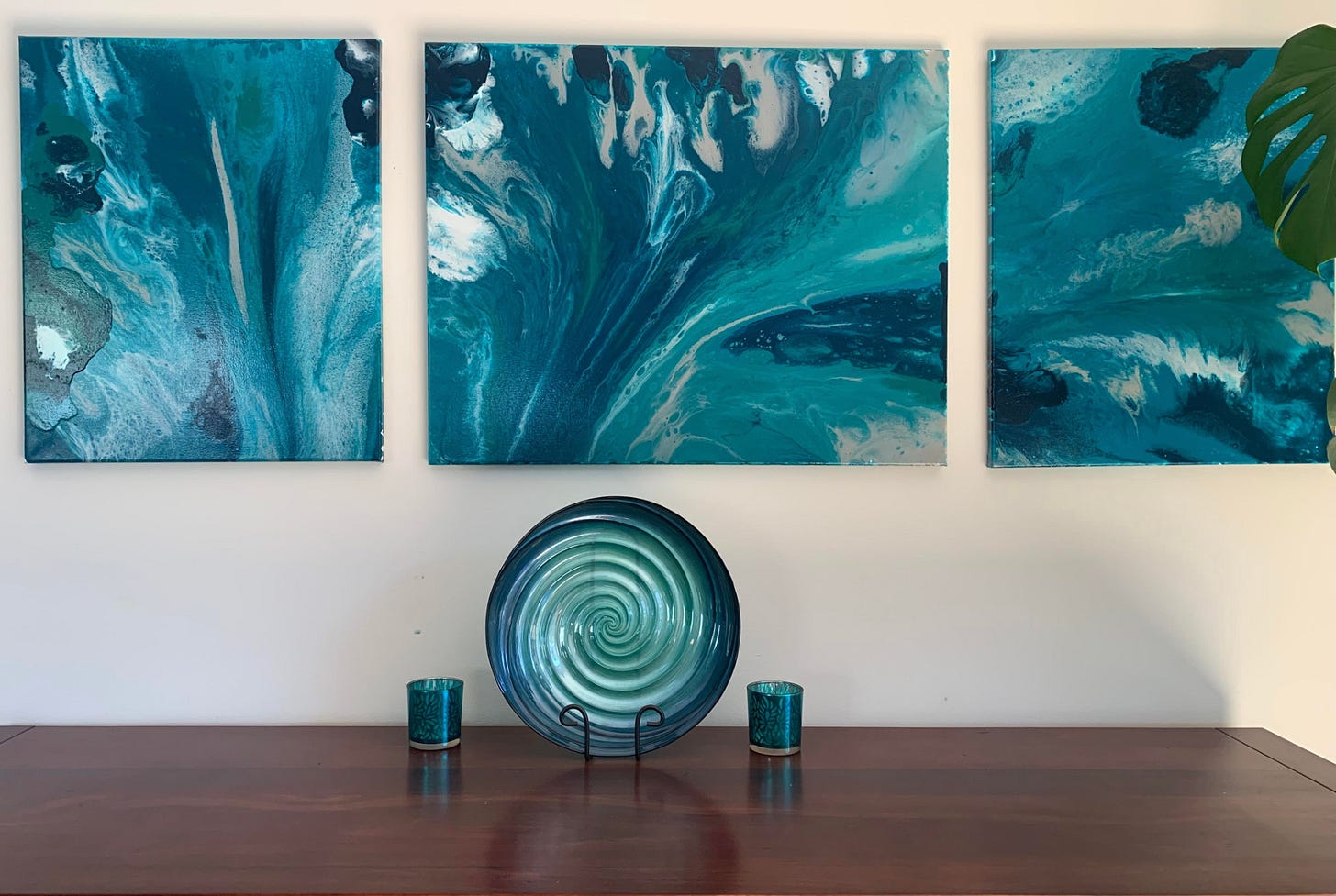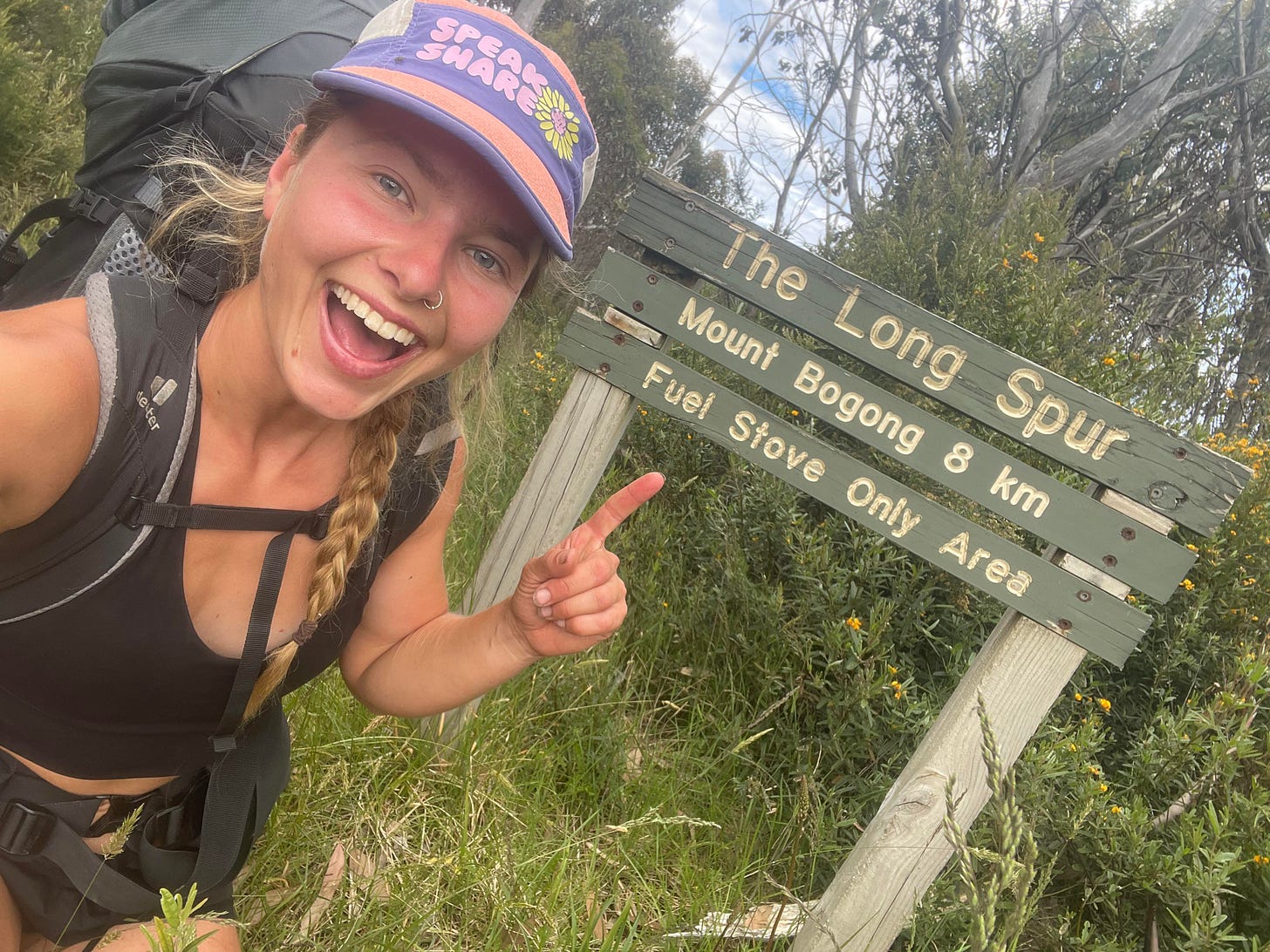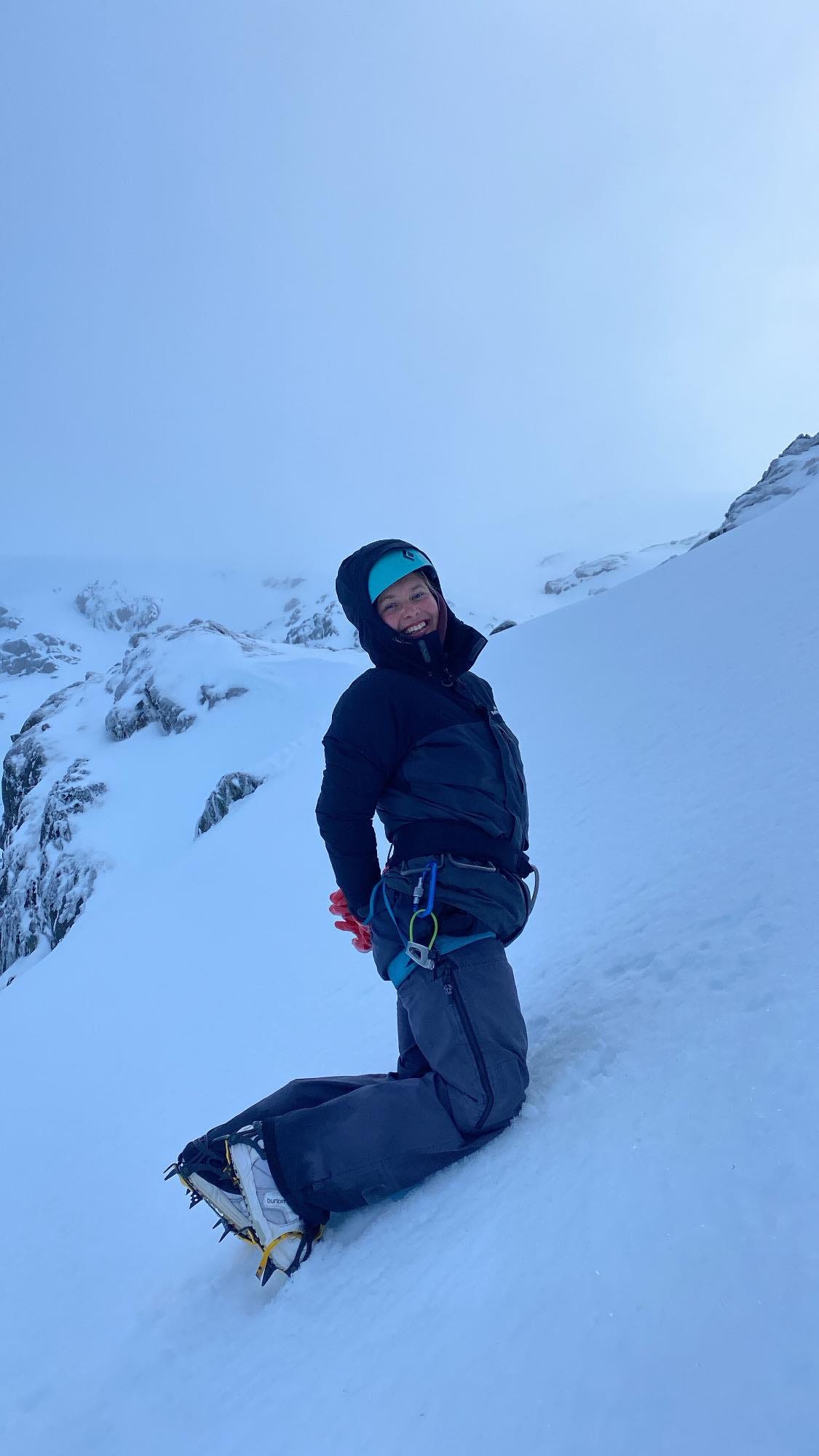Elise Marcianti on recovery, community and paving your own path
Building strength and resilience through nature and the outdoor community.
Trekking 300 kilometres through the Australian Alps won't break the internet. Nor will it earn you an adventure grant, a North Face sponsorship or a spot in the history books. But for Elise Marcianti, a 24-year-old artist and adventurer, tackling a 50km ultramarathon to Australia’s highest point, followed by a 250-kilometre hike along the Australian Alps Walking Track, meant more than financial gain or a fastest known time. Having struggled with anorexia through her late teens, Elise undertook this challenge to apply everything she’d learned during recovery and test her mental and physical strength.
‘It was a lot harder than I thought,’ says Elise, who grew up in Melbourne but now calls Victoria’s alpine region home. ‘It wasn’t, like, this is so fun and pretty. I threw up from the heat and slogging uphill with a heavy backpack. I’ve got bruises all over me from getting hit by hail. Every day was my limit. I was tired. I was navigating. There was no reception and a lot more bush-bashing than I thought. At times there was no track and I was just pushing bushes out of the way, but I think that’s what made it such a special journey.’
Elise’s journey – labelled Moving for the Mind – began in Thredbo, New South Wales, and ended in Harrietville, Victoria, at the base of Mount Feathertop. She used the adventure as an opportunity to raise money for Eating Disorders Families Australia, a cause that’s close to her heart, and though she completed the walk in 16 days, it took months of preparation for Elise to be in a place to even begin.

‘There was so much planning that went into it,’ she says. ‘I had to work out where the water is, set up the GPS tracking, dehydrate my own food and organise food drops. It took months of Excel spreadsheets and I don't really do Excel.’
Logistics is one side of the coin; on the other, there’s the physical and mental preparation, and Elise is quick to credit her battle with anorexia for the latter. ‘I think I gained a lot of my strength – especially mental – from the experience. There was actually a lot that came from it and I had a really deep “why”. It helped me stay in a hard time without complaining.’
At any given time, the number of Australians with an eating disorder is estimated to be around one million. Anorexia nervosa has the highest mortality rate of any eating disorder – one of the highest rates of all psychiatric disease – with cardiovascular complications being the leading cause of death, followed by suicide. According to Eating Disorders Victoria, people with anorexia nervosa are 31 times more likely to attempt suicide than the general population.
A recently published study suggests that high rates of eating disorders can be found in the ultra-running community, too. According to Runner’s World, the prevalence of eating disorders among study participants ranged between 32 and 62.5 per cent while exercise addiction also affected a substantial portion of ultrarunners, with rates varying from 11.5 to 18.2 per cent. The study indicated that exercise addiction wasn’t just tied to training volume or race distance, but also to the individual’s relationship with exercise, underscoring the relationship between physical activity and mental well-being.
“It wasn’t the life I’d signed up for. I knew I was made for more, and that if I didn’t actively change and recover, it was only going to get worse.”
Elise is wary of people perceiving her efforts as overexercising given her history and love of adventure and endurance sports. ‘It [overexercising] was once a factor,’ she says, ‘because I was exercising to lose weight when I was unwell. I think it’s been a really interesting journey because I do it for the right reasons now; it’s something that makes me feel good, and it’s good for my mental health. But that same thing can also be bad and I’ve had to put in a lot of boundaries.’
Those boundaries were by no means easy to set. Elise’s three years in treatment were, she says, pretty scary. ‘You hear about it [anorexia] in the media as someone not eating much, but when you’re actually going through treatment and seeing the other side, it’s horrific. There was a woman next to me [in the hospital], who was forty or fifty, and I didn't think she was going to make it much longer at all. Another year, maybe. And it felt like I was seeing my future. It wasn’t the life I’d signed up for. I knew I was made for more, and that if I didn’t actively change and recover, it was only going to get worse.’
During recovery, Elise was wholly focused on rebuilding herself; goal-setting, working out how she wanted to live her life, and making sure it all came from healthy intentions. How could she work out and get strong while maintaining a healthy relationship with her body? How would she prevent things from going too far?
‘I went through a personal development program and started to have some breakthroughs with all the parts of me that were, like, a dreamer,’ says Elise. ‘I wanted to go on an East Coast trip, to travel and do all these things. And I knew that if I was unwell I wouldn't be able to. It was one or the other. For two years it was a really hard headspace to be in, because it was a constant fight between staying unwell and having the life I wanted and I couldn't have both. Like, I couldn't be fighting over a meal then going to a personal development meeting. It felt like a lose-lose situation because I could either ignore my eating disorder and feel like a failure because I’d eaten, or I could listen to the disorder and get worse.’

Recovery was hard on Elise’s family, too, which is why she chose to raise funds for Eating Disorders Families Australia. Her family became her fulltime support, quitting their jobs to stay home and care for her. They didn’t know anyone who had been through something similar and resorted to buying books on eBay – and hiding them from Elise – to understand what she was facing and learn how to support her.
‘I think the biggest gap, the area where there hasn’t been any attention paid, is with the carers,’ says Elise. ‘I don’t think they [her family] have been able to truly get past what we went through together. The stress and trauma it put on them was huge and they were left in a place of massive hardship. If you’re only looking at the individual, you’re neglecting two or three other people.’
In the end, Elise came out of recovery with a strong sense of identity. She took a year to do the things she’d always wanted to do but hadn’t had time for, like a surfing trip up Australia’s East Coast. She says she had initially been in a discovery period, doing some travelling and learning, which then progressed to more adventurous endeavours like trail running, hiking, high-lining and climbing. She’s learned a lot, she says, and now wants to spend time sharing her experiences and helping others. Especially since a big contributor to her illness, she thinks, was feeling disconnected, isolated and alone. Once she regained that connection, she began to feel like she was part of something bigger. Like she had a new sense of purpose.
‘I had quite a few people messaging me on the hike saying they wanted to do something similar but they just didn't know the right people or have the community. And I really think you just have to keep showing up to the places, the environment, the activities. From there you slowly build the community and it then becomes a lifestyle. I don't know if I necessarily have advice, but I do think the outdoors is a really healing place to be in. It helps teach you about vulnerability, and when you learn in nature, you learn about yourself.’
It was a combination of this desire to learn about herself and her search for community that inspired Elise to start Explore Your Core, her podcast, which began in 2021. The podcast features conversations with people who have paved their own path in life, covering topics like mental health, art, adventure and community.
‘I’m trying to make my own way too,’ says Elise, ‘and I've found it incredibly difficult to navigate. It’s daunting as an artist – you’re putting something you’ve created out in the world and your work is vulnerable. You’re not guaranteed money or anything, you can’t just rock up and clock on. I wanted to build a bit of a community around it and once I started, once I became more interested in adventure and entrepreneurship, I realised it goes so much further. I think a lot of people have a passion – art, photography, writing, adventure – but there’s no set career path, so I’ve enjoyed having conversations about how to make that work.’

Now, Elise plans to stitch together a short film using the footage she shot during her trek. She hopes to show that recovery is possible, as is building a life you want to live, and recovery has taught her that there’s nothing more important than looking after the mind and making it a priority. ‘I want to be someone who shows and lives that,’ she says, ‘rather than just raising some money for a good cause. It’s amazing what they [EFDA] are doing, but for this hiking journey, I think I want to be the person who has done it and can show others that it’s possible.’
Support Elise and help make a difference to families living with eating disorders by donating to Moving for the Mind. You can also follow Elise on Instagram or listen to Explore Your Core on Spotify.
A note on People & Places
You may have noticed that P&P offers a paid subscription option. This works as a kind of tip jar, so if you’d like to offer monetary support, please consider becoming a paid subscriber below. For now there is no difference in what you receive as a free or paid subscriber; either way, you’re appreciated. Thanks again for being here.








